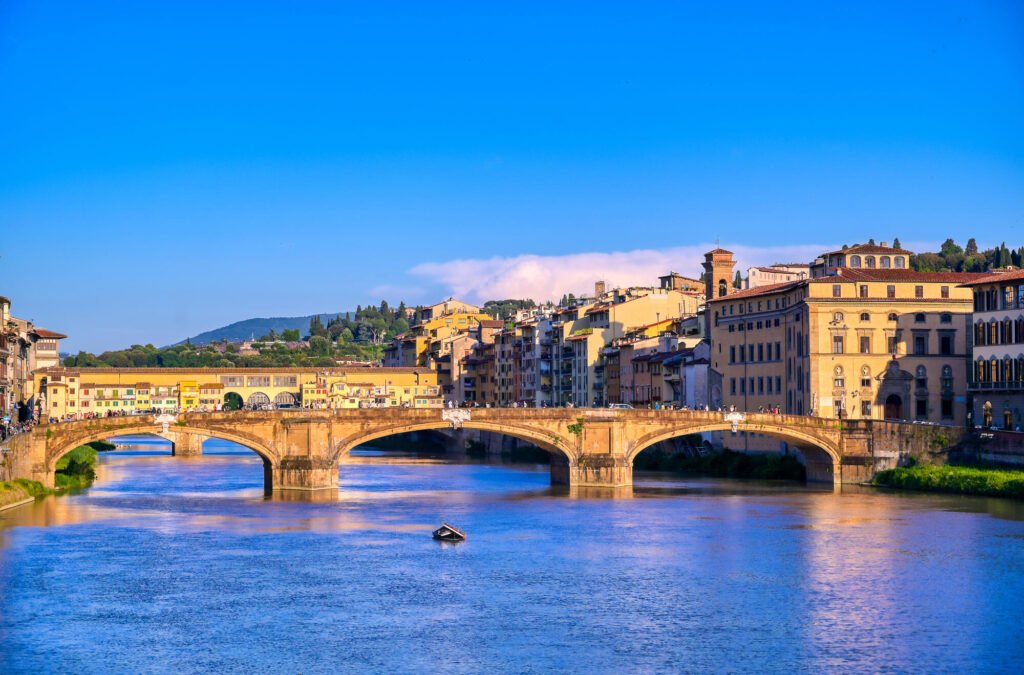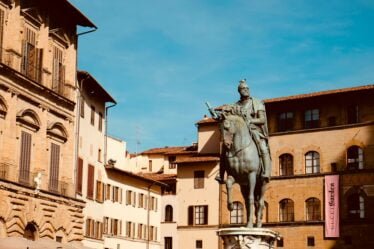

Introduction
In the following text, we will explore the curious story of the Rams Under Santa Trinita, a pair of ram’s heads sculpted on the Ponte Santa Trinita in Florence. These heads, commissioned by Cosimo I de’ Medici and attributed to a design influenced by Michelangelo, bear fierce and gentle expressions that tell a symbolic tale.
Rams Under Santa Trinita
Historical Background
First of all, the Ponte Santa Trinita (Holy Trinity Bridge) is a Renaissance bridge spanning the Arno in Florence. (tour.florence.it) After a flood in 1557, Cosimo I de’ Medici ordered Bartolomeo Ammannati to rebuild the bridge, possibly using a sketch or idea from Michelangelo, who at that time was living in Rome. (italyscapes.com) The reconstruction took place between 1567 and 1571. (Il Restauro Architettonico)
Moreover, this bridge is architecturally significant: it has three flattened elliptical arches, which give it a very elegant and light silhouette. (tour.florence.it)
The Two Ram Heads: Symbolism and Expression
Transitioning to the heart of the matter, the two ram (or “ariete” in Italian) heads are placed under the bridge, attached to the piers. According to the story, Cosimo I chose the ram as a symbol, because the ram (Ariete) was his astrologicalilooking at these rams by boat, you can clearly see their expressions — something that is harder to perceive from the bridge itself or from the Lungarni.
- The first ram (on one side) looks wild and furious. It has a little hair on its nose, and its expression is “crossed” or angry, as if it’s ready to attack. In local lore, this is because on that side “la fiera” (the flood) used to come, and this ram seems to be glaring at the raging waters, as if warning them: “don’t you dare destroy my bridge again!”
- The second ram (on the opposite side) seems happy, calm, and peaceful. It has a more serene face, without the hair on the nose, as if the danger has passed and everything is under control. The idea is that when the flood recedes, the “fiera” (the floodwaters) flow away toward Pisa — which historically was an enemy of Florence — so that second ram is relieved, even joyful, seeing that the threat has left.
In short, these two heads are not identical: one is furious and beast-like, the other tranquil — capturing a dual symbolism of danger and peace, or threat and relief.
Architectural and Artistic Significance
Furthermore, the use of the ram’s heads is deeply symbolic. The ram, as the emblem (or “elettivo segno”) of Cosimo I de’ Medici, ties the sculpture back to the Medici family’s power and identity. (Firenze Made in Tuscany)
Also, the bridge’s structural design is quite innovative: the inverted catenary (or very flattened arch) was a clever solution to combine strength with elegance. (Il Restauro Architettonico) The bridge’s piers (the supports in the water) were built with acute-angled sections, so they would offer less resistance to debris carried by the river — a very practical, engineering-conscious detail. (Il Restauro Architettonico)
The bridge also features statues of the Four Seasons, placed at its corners in 1608, made by Pietro Francavilla, Giovanni Caccini, and Taddeo Landini. (FeelFlorence)
Restoration and Legacy
Over time, the Ponte Santa Trinita has seen destruction and rebirth. During World War II, retreating German troops destroyed the bridge in 1944. (Wikipedia) After the war, it was painstakingly reconstructed (1952–1958) using as many of the original stones as possible. (italianculturalsociety.org)
The restoration is considered a triumph of architectural heritage: careful scientific measurements, historical sensitivity, and engineering skill combined to restore the bridge “as it was, where it was.” (Il Restauro Architettonico)
Today, from the Arno by boat, one can again admire the two dramatic ram heads — a subtle but powerful reminder of Cosimo’s symbolic presence, his fears, and his triumphs.
Why the Rams Matter: Interpretation and Symbolism
- Political Identity: The ram heads are not just decorative; they reflect Cosimo I’s personal or dynastic symbol, asserting Medici authority right on the bridge.
- Natural Threat vs Control
- The two ram heads show Florence’s relationship with the Arno. One ram looks furious. It represents the river as a dangerous force that can cause floods and damage. The other ram looks calm and peaceful. It symbolizes the river once it becomes manageable again. Together, they show the contrast between fear and safety.
- Artistic Dialogue
- Michelangelo may have inspired Ammannati’s work on the bridge. This possible influence connects the ram heads to the High Renaissance. As a result, the bridge is not only an engineering project. It also becomes a true artistic creation.
- Resilience and Memory
- The bridge suffered destruction during the war. Later, it was rebuilt with great care. Today, the structure and the ram heads remind us of Florence’s dedication to protecting its history. They stand as symbols of strength, continuity, and respect for the past.
Conclusion
The Rams Under Santa Trinita offer more than a curious detail on a bridge: they are a multi-layered symbol of Medici power, the perils of nature, and artistic ambition. They help us feel the tension between fear and relief, between threat and safety, and they root that emotional narrative in the very architecture of Florence.
External Links for Further Reading
- Wikipedia – Ponte Santa Trinita (Wikipedia)
- Visit Tuscany – The Bridges of Florence (including Santa Trinita) (Visit Tuscany)
- Firenze Made in Tuscany – The Florence of Cosimo I (Firenze Made in Tuscany)
- Il Restauro Architettonico – Restoration of Ponte Santa Trinita (Il Restauro Architettonico)



